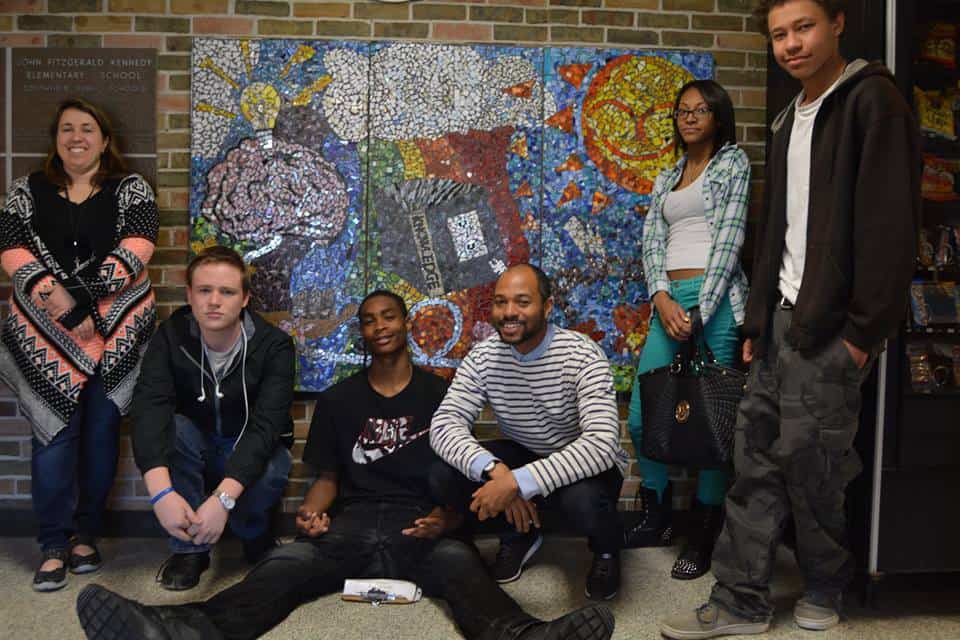Detroit Future Schools Data Murals Project: What Stories Can We Tell From Data?
Words by Detroit Future Schools
During the 2014-2015 school year, Detroit Future Schools completed two “data mural” projects in Detroit schools, supported by the Knight Arts Challenge and the Michigan Council for Arts & Cultural Affairs.
A data mural is public art that engages community members in a dialogue about data-driven representations and misrepresentations of their community. We worked with two of our anchor schools – the The James and Grace Lee Boggs School and Tri County Educational Center – to create the data murals over the course of six months.
Our goal was to conduct research with each classroom about their school communities and convey our findings through public art. Each classroom was paired with a Detroit Future Schools teaching artist who helped them express their research through compelling visual language and graphics.
The Boggs School: How to be a Boggs School Student?
At The James and Grace Lee Boggs School, teaching artist Alicia López Castañeda worked with the 2nd and 3rd grade students of the “Painted Turtles” classroom and their teacher Liz Kirk to develop a mural based on the question, “How to be a Boggs School Student?” inspired by the classroom’s “how-to” writing unit. The mural would also serve as a kind of “how-to” text to pass on to future Boggs School students.
The students brainstormed around this question through creative writing activities that considered: Who are we? Where do we come from? What do we know how to do?” They used digital audio recorders to interview each other and from the answers they developed their own “data set” around the theme of how to be a Boggs School student. They displayed this data in the form of a map, then clustered the information into three major themes of identity, literacy, and friendship.
Alex B. Hill, a local graphic designer and infographic maker led the students through a drawing exercise in which they translated the information they wanted to convey into a visual language of faces, letters, and flowers. Muralist Phil Simpson compiled the students’ original drawings into a final design that conveyed the story that they wanted to tell.
The project’s learning community expanded beyond the classroom to include the school and its surrounding community. At the end-of-the-year block party, students participated in a skill-share at which they created and shared “how-to” texts or manuals that taught hands-on skills such as how to knit, how to do backflips, and more. The data mural ended up becoming a community project as family and friends helped finish the painting. These school-community interactions strengthened and reinforced the Boggs School’s commitment to place-based education.
By placing the students at the center of the curriculum it shook up the normal dynamics of a classroom. In the skill-share the teacher-student dynamic shifted as students became teachers, and teachers moved out of their traditional roles as the sole distributors of information. Instead everyone became an authority of their own knowledge. Learn more about the process of making the mural here.
The DFS Data Murals project cultivated essential character skills in the students, such as collaboration, empathy and grit – three of the “DFS 11 Essential Skills.” When asked to define these skills during an end-of-program interview, one third grade student answered, “collaboration is when kids do it together and they include everyone. Empathy is when – let’s say Raphael is sad – I would come over to Raphael and I would know how he felt because I’ve been sad before and I know how it feels to be sad. Grit is when someone wants to give up, and they don’t give up.”
Tri County Educational Center: How Do Schools Measure Success?
Tri-County Educational Center (TCEC) is an alternative school for Metro Detroit, serving young people who have either dropped out or been expelled from other school districts. Detroit Future Schools program director Nate Mullen worked with graphic design students in the 9th through 12th grades, along teachers Adelaide Fabiilli and Brooke Leiberman, to create their data mural.

They used drawing, painting, graphic design, student-led research, and mosaic art to explore the question “Can Design Save the World?” The students brainstormed problems in their community that they wanted to address through graphic design and determined to focus their research on the obstacles that prevent students from graduating from high school. Starting with the question, “How do schools measure success?”, they researched standardized testing, interviewed their school principal, and surveyed fellow students. Through a process of mosaic design, the mural evolved to become a graphic representation of the students’ many different ideas of success. Learn more about the process of making the mural here.
In describing the mural, one student wrote, “the mural represents that there are multiple ways of deeming yourself successful. The most intricate message is the brain, which shows knowledge in a book beside it. This explains that knowledge is very important when becoming successful.”
The Data Murals project gave us the opportunity to create captivating public art that merges the talents of artists with the stories of communities and the leadership of young people. The murals also helped spark conversation within the broader community through their unveiling at end-of-the-year events including the TCEC Spring Festival and the Boggs School community block party.